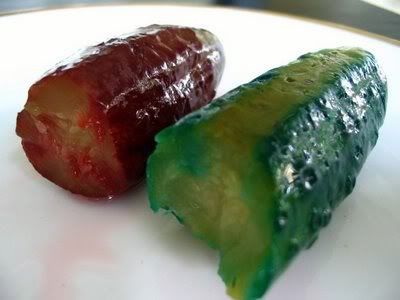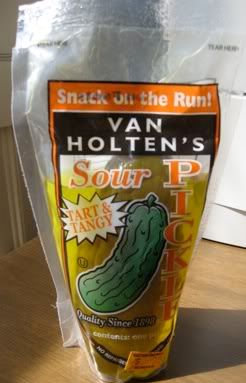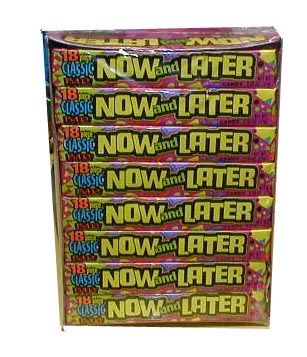SOUTHSIDE CANDY DILL PICKLES
 Food in Chicago is specific - There is a correct way to eat a hot dog, a special kind of dough for deep dish pizza, and hundreds of ethnic food traditions that slam into each other like an elegant wrestling match. Food in Chicago is a crazy quilt, a hodge-podge of style and substance. And in some cases, Chicago food offers up ideas so radical in their awkwardness, so unique in their flavors that they must be illuminated.
Food in Chicago is specific - There is a correct way to eat a hot dog, a special kind of dough for deep dish pizza, and hundreds of ethnic food traditions that slam into each other like an elegant wrestling match. Food in Chicago is a crazy quilt, a hodge-podge of style and substance. And in some cases, Chicago food offers up ideas so radical in their awkwardness, so unique in their flavors that they must be illuminated. It’s time to discuss the Southside pickle phenomenon.
Chicago is the most segregated city in the country. Unlike New York City and LA where cultures seem to jump into a blender and coagulate, Chicago is tribal in the purest sense of the word. Immigrants have been migrating to the Midwestern hub for a few hundred years. Dozens of ethnic groups from Europe, South America, Asia, Africa, and the Middle East, have all carved out little hamlets within the city walls. Before the 1960s, Chicago was essentially a black and white city with a strong working class immigrant aesthetic. Most middle class immigrants sought work in Chicago’s stockyards or hundreds of factories that created everything from cookies to football helmets. Chicago now contains immigrants from every country on the planet, and this diversity is what makes Chicago so interesting. That being said, Chicago is still segregated on racial lines, with the Northside remaining a bastion of whiteness and the Southside an enclave of blackness. These lines, while invisible, are very real when talking about culture, lifestyle and snack food.
Enter the pickle and its friends Kool-Aid, Now and Later, Jolly Rancher, and peppermint stick. The pickle, while nothing more than a small cucumber soaked in vinegar brine, has achieved legendary status within the invisible boundary of Chicago’s Southside African American community.
 In Chicago, a pickle is not just something eaten with a pastrami sandwich; it is a briny vehicle for youthful experimentation and hilarious creativity. For decades young people on Chicago’s Southside have been combining pickles with candy, Kool-Aid, and other snack foods to create tastes and flavors that are uniquely Chicago. This pickle experimentation can be traced to the great migration of southern black workers in the middle of the 20th Century. Pickling in the South has long been an easy and delicious way to preserve perishable food items. People in the Southern United States pickle everything from peaches to pigs-feet. What differentiates Chicago pickle enthusiasts from their southern brethren is the youthful insanity of the flavor combinations.
In Chicago, a pickle is not just something eaten with a pastrami sandwich; it is a briny vehicle for youthful experimentation and hilarious creativity. For decades young people on Chicago’s Southside have been combining pickles with candy, Kool-Aid, and other snack foods to create tastes and flavors that are uniquely Chicago. This pickle experimentation can be traced to the great migration of southern black workers in the middle of the 20th Century. Pickling in the South has long been an easy and delicious way to preserve perishable food items. People in the Southern United States pickle everything from peaches to pigs-feet. What differentiates Chicago pickle enthusiasts from their southern brethren is the youthful insanity of the flavor combinations. One such combination is the peppermint-pickle. One of the longest standing pickle experiments, this delicacy has its roots in Chicago, and continues to be a popular treat for kids and adults on Chicago’s Southside.
 The peppermint pickle is made by removing the top off of a large kosher dill pickle and inserting a candy-cane sized peppermint stick into the pickle's cavity. The result is a salty, sweet, mint flavored, crunchy treat that is both funky and delicious. The acid from the vinegar in the pickle brine melts the peppermint stick, and allows the astringent peppermint flavor to soak deep into the pickle.
The peppermint pickle is made by removing the top off of a large kosher dill pickle and inserting a candy-cane sized peppermint stick into the pickle's cavity. The result is a salty, sweet, mint flavored, crunchy treat that is both funky and delicious. The acid from the vinegar in the pickle brine melts the peppermint stick, and allows the astringent peppermint flavor to soak deep into the pickle. There are variations of this treat that include placing a Jolly Rancher hard candy, or Now and Later taffy within a large pickle. These candy pickles reached fever pitch during the mid-1990s when Kool-Aid pickles began making the scene on Chicago’s Southside. These pickles, again having roots in the deep-south, combine kosher dill pickles with packets of strawberry, cherry, or fruit punch Kool-Aid. The pickles are placed in a large jar filled with extra sweet Kool-Aid and left to soak for up to a week. The candied pickles were invented by African American school kids in southern states like Georgia and Mississippi, and as their popularity grew, they made their way to Chicago. In Chicago, these candy colored, sweet-tart pickles can be found in candy houses, corner stores and neighborhood shops all over the Southside. This childhood delicacy has now become so popular that Kool-Aid pickles have been used in gourmet BBQ joints from Los Angeles to New York City, and were even featured in the food section of the New York Times.
There are variations of this treat that include placing a Jolly Rancher hard candy, or Now and Later taffy within a large pickle. These candy pickles reached fever pitch during the mid-1990s when Kool-Aid pickles began making the scene on Chicago’s Southside. These pickles, again having roots in the deep-south, combine kosher dill pickles with packets of strawberry, cherry, or fruit punch Kool-Aid. The pickles are placed in a large jar filled with extra sweet Kool-Aid and left to soak for up to a week. The candied pickles were invented by African American school kids in southern states like Georgia and Mississippi, and as their popularity grew, they made their way to Chicago. In Chicago, these candy colored, sweet-tart pickles can be found in candy houses, corner stores and neighborhood shops all over the Southside. This childhood delicacy has now become so popular that Kool-Aid pickles have been used in gourmet BBQ joints from Los Angeles to New York City, and were even featured in the food section of the New York Times. Chicago is still a town where childhood experimentation and cultural gastronomy can slow dance together and concoct something as wonderfully tasty as the candy pickle.

Christ. I've been stuck in Chicago suburbia for 30 years for medical reasons, and have never been able to penetrate Chicago's culture. I'm not really talking about the business with the pickles, but everything.
ReplyDeleteGood post. A friend of mine grew up on the South Side (white guy) and told me about the peppermint stick in a pickle phenom. I demanded to see evidence.
ReplyDeleteHe just sent me a link to a 1997 song by Vernon Garrett called Dill Pickle and a Peppermint Stick. Can't wait to listen to it.
lulz
ReplyDeleteYeeeeeeesssss nothing like a dill pickle and peppermint. Yuuuummmmm
ReplyDeleteYeeeeeeesssss nothing like a dill pickle and peppermint. Yuuuummmmm
ReplyDeleteThe Pizza Hut menu
ReplyDeletehas been a long standing favorite of those who like to indulge in some gourmet food while they are at the comfort of their homes.
Many foods are fortified with these vitamins and minerals, which make up for the missing nutrients. Nevertheless, fortified foods must be labeled to protect consumers from getting poisoned. Source for more about food tips.
ReplyDeleteWith the right amount of food, we will feel satisfied and healthy! The USDA Food Patterns are recommendations for each food group. These are not recommendations for every person's diet. You are curious to know more about best dog food, find out here.
ReplyDeleteFor an upscale dinner, try a French restaurant or a classic American restaurant. If you are traveling with children, a place like Frank Fat's is a great option. For more details about mexican restaurants in sacramento, pop over to these guys.
ReplyDelete